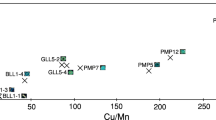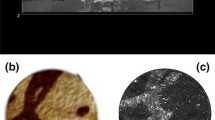Abstract
The compounds responsible for the colors and decorations in glass and glazed ceramics include: coloring agents (transition-metal ions), pigments (micro- and nanoprecipitates of compounds that either do not dissolve or recrystallize in the glassy matrix) and opacifiers (microcrystalline compounds with high light scattering capability). Their composition, structure and range of stability are highly dependent not only on the composition but also on the procedures followed to obtain them. Chemical composition of the colorants and crystallites may be obtained by means of SEM-EDX and WDX. Synchrotron radiation micro-X-ray diffraction (SR-micro-XRD) has a small beam size adequate (10 to 50 microns footprint size) to obtain the structural information of crystalline compounds and high brilliance, optimal for determining the crystallites even when present in low amounts. In addition, in glass decorations the crystallites often appear forming thin layers (from 10 to 100 micrometers thick) and they show a depth-dependent composition and crystal structure. Their nature and distribution across the glass/glaze decorations gives direct information on the technology of production and stability and may be related to the color and appearance. A selection of glass and glaze coloring agents and decorations are studied by means of SR-micro-XRD and SEM-EDX including: manganese brown, antimony yellow, red copper lusters and cobalt blue. The selection includes Medieval (Islamic, and Hispano Moresque) and Renaissance tin-glazed ceramics from the 10th to the 17th century AD.





Similar content being viewed by others
References
T. Pradell, J. Molera, N. Salvadó, A. Labrador, Appl. Phys. A 99, 407 (2010)
J.G. Iñañez, M. Madrid-Fernández, J. Molera, R.J. Speakman, T. Pradell, J. Archaeol. Sci. 39 (2012). doi:10.1016/j.jas.2012.09.015
J. Molera, J. Coll, A. Labrador, T. Pradell. Appl. Clay Sci. (submitted)
P. Colomban, Appl. Phys. A 79, 167 (2004)
M.S. Tite, J. Archaeol. Sci. 36, 2065 (2009)
S. Coentro, J.M. Mimoso, A.M. Lima, A.S. Silva, A.N. Pais, V.S.F. Muralha, J. Eur. Ceram. Soc. 32, 37 (2012)
F. Rosi, V. Manuali, C. Miliani, B.G. Brunetti, A. Sgamellotti, T. Grygarc, D. Hradil, J. Raman Spectrosc. 40, 107 (2009)
F. Rosi, V. Manuali, T. Grygar, P. Bezdicka, B.G. Brunetti, A. Sgamellotti, L. Burgio, C. Seccaronif, C. Miliani, J. Raman Spectrosc. 42, 407 (2011)
C. Moretti, S. Hreglich, Glass Technol. 25(6), 277 (1984)
F.P. Glasser, Am. Mineral. 52, 1085 (1962)
B. Sorensen, S. Gaal, E. Ringdalen, M. Tangstad, R. Kononov, O. Ostrovskic, Int. J. Miner. Process. 94, 101 (2010)
J. Molera, T. Pradell, N. Salvadó, M. Vendrell-Saz, in From Mine to Microscope: Advances in the Study of Ancient Technology, ed. by A. Shortland, I.C. Freestone, T. Rehren (Oxbow Books, Oxford, 2009), Chap. 1
FactSage, Phase diagram MnO–SiO2–O2 p(O2)=0.21 atm. Phase diagram MnO–SiO2–O2 p(O2)=0.01 atm. FToxid–FACT oxide database (2010)
B. Gratuze, I. Soulier, M. Blet, L. Vallauri, Rev. Archéom. 20, 77 (1996)
C. Viti, I. Borgia, B. Brunetti, A. Sgamellotti, M. Mellini, J. Cult. Herit. 4, 199 (2003)
A. Bouquillon, M. Bormand, A. Zucchiatti, Della Robbia (SAGEP Editori, Genova, 2011)
J. Perez-Arantegui, M. Resano, E. Garcıa-Ruiz, F. Vanhaecke, C. Roldan, J. Ferrero, J. Coll, Talanta 74, 1271 (2008)
J. Pérez-Arantegui, B. Montull, M. Resano, J.M. Ortega, J. Eur. Ceram. Soc. 29, 2499 (2009)
Acknowledgements
The study is funded by CICYT grant MAT2010-20129-C02-01 and Generalitat de Catalunya grants 2009SGR01225 and 2009SGR01251. The authors would also like to express their acknowledgement to Maria Antonia Casanova from Museu de Ceràmica de Barcelona, Guillem Rosselló Bordoy from Museu de Mallorca, Joan Casas, archaeologist from Sant Bartomeu de Grau, Alessandra Cereda from the Ashmolean Museum and Michael S. Tite for providing the ceramics analyzed.
Author information
Authors and Affiliations
Corresponding author
Rights and permissions
About this article
Cite this article
Pradell, T., Molina, G., Molera, J. et al. The use of micro-XRD for the study of glaze color decorations. Appl. Phys. A 111, 121–127 (2013). https://doi.org/10.1007/s00339-012-7445-x
Received:
Accepted:
Published:
Issue Date:
DOI: https://doi.org/10.1007/s00339-012-7445-x




